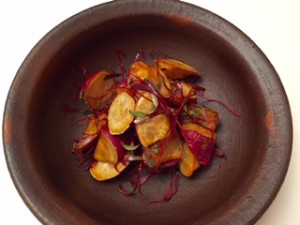At this time of the year every Friday I make pilgrimage to Samascott Orchard at Union Square farmers Market. The outside is cold and market looks scares. Samascott Orchard sell the best apples and satsuma-imo, Japanese sweet potato, in the market.
The Samastocc Orchard was founded in 1901 in Columbia County. Grandfather of Ron and Gary Samascott began growing apples. Their son, Oliver, converted the orchard to a dairy farm in 1930s, during which he kept buying land. Now they own 1,000 acres, and 350 of which is cultivated. Oliver shifted from dairy to apple and vegetable farm. The farm is selling their produce since 1984. Farmers Market convinced the family to keep farming, and their sons are farm partners, too. Big thumbs up to Farmers Market.
Samascott Orchard carries different varieties of apples at different time of short apple season. Here are my favorites. Akane: early mid season apple; crisp, sour and flavorful. It reminds me of kogyoku in Japan. Peppin: late season apple; old NY cultivar, green-yellow skin, crisp with a slight pear like fragrance and texture. Winesap: old season apple; crisp, acid and flavorful. Samascott Orchard has a very simple pricing system. Any apple sold at their outdoor store – over 10 varieties – is priced at $1.50 per pound (it was $1.25 per pound last year). It is the cheapest among other venders in the market. If you live in Manhattan, do not miss their apple.
Baked very sweet, sweet potato, ishi-yakiimo, was a popular winter snack sold on the streets of small towns and big cities alike by vendors selling from their small wooden carts or pickup trucks, when I was grown up in Japan. Each vendor chants his distinctive sales cry as the sweet smell of baked sweet potatoes permeates the area. Sweet potatoes are baked by being immersed in tiny heated pebbles over a wood or charcoal fire. This method produces the perfect caramelization of carbohydrate in sweet potato. The resulting sweet potato is heavenly, sugar sweet.
Our love to ishi-yakiimo continues in Japan, but the number of street vendors operating today have plummeted. Ishi-yakiimo lovers now head to convenience stores or supermarkets. I rather stop eating it if that is the case, and find some solutions.
On my online search I found a tempting cooking pot, which says we can prepare authentic ishi-yakiimo at home. If I live in Japan right now I immediately invest in this special pot, which comes with pebbles! https://www.pro-douguya.com/na-fu-ha-iy24.html The pot is made of enameled metal ware. Induction heat created in the pot cooks the sweet potato to the state of authentic ishi-yakiimo texture and flavor. Since this solution does not work for me here in NY, here is my  second solution with satsuma-imo. I bake it in the oven; fry it in oil; simmer it in flavored stock, and stir-fry it. At this very special moment of the year I made satsumaimo, Japanese sweet potato latkes, potato pancake. It was delicious.
second solution with satsuma-imo. I bake it in the oven; fry it in oil; simmer it in flavored stock, and stir-fry it. At this very special moment of the year I made satsumaimo, Japanese sweet potato latkes, potato pancake. It was delicious.
 Here is a very simple recipe for you. Fried sweet potato with Ponzu sauce.
Here is a very simple recipe for you. Fried sweet potato with Ponzu sauce.
2 sweet potatoes, cut into small bite sized pieces (use rangiri technique)
Canola oil
Sea salt
Ponzu sauce (you can find the recipe in The Japanese Kitchen, Hiroko’s American Kitchen and The Sushi Experience)
Heat the canola oil in a wok for fryer to 300°F. Add the sweet potato pieces and cook them at around 270°F until lightly golden, about 8 minutes. Remove the sweet potato from the oil and toss with pinch salt and generous amount of Ponzu sauce. Serve immediately.


